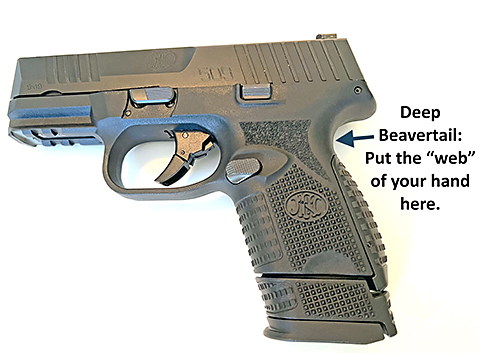Home on the Range

 By MARJ LAW
After taking a basic class on handguns and learning the rules of the range, Newbie is set to learn more about hanging on to her (or his) gun.
By MARJ LAW
After taking a basic class on handguns and learning the rules of the range, Newbie is set to learn more about hanging on to her (or his) gun.
First, as in the safety class, newbies are pointing their guns safely downrange when the range is “hot.”
Is our newbie today a young man?
The cool factor can be the first hindrance to a young man’s shooting. See him squinch his eyes at the target? See him punch out his right hand gangsta-fashion turning the gun 90’ sideways? Or maybe his first stance will be to turn his body sideways and shoot one-handed, even though he’s never practiced before? Or maybe he figures he knows quite a bit, aims at the target and shoots off one round after another as fast as he can?
Yikes. So Not cool.
Now, how about a middle-age newbie? What’s she doing?
She has put her elbows on the shooting bench and is eyeing the target. She puts her left hand (the non-dominant one) under the hand that holds the gun. She knows the gun will go off with a bang, so she’s got her head turned away from the target and her eyes are squinched shut.
Both newbies first grips are screaming “help me!”
For every action, there’s an equal and opposite reaction. When the firing explosion propels the bullet out of your gun, the slide returns with equal force. Our gangsta-shootin’ guy has his gun right in front of his body. The force of the gun’s firing is going to repel his gun right back at him.
Not good.
Shooting one-handed with no experience? Not likely to be successful at hitting the target. Shooting one after another really fast? If you haven’t learned to do it right the first time, will it be any better if you keep making that same mistake?
Learning a bit about how you hold your gun is a good beginning to shooting well.
Watch Newbie at the shooting bench. Newbie is leaning backwards from the waist. A backwards tilt? Yes, he’s given himself away as a newbie. A gentle slightly-forward slant begins good shooting.
Did you ever hear your grandfather say: “He shakes hands like he’s holding a dead fish!”
Your gun isn’t a dead fish. Hold it really firmly. Don’t give yourself the shakes, but grip strongly.
Where is your hand on the grip? Just anywhere is not good enough!
See the indentation on the backstrap below the slide? When you hold your gun, that tender webbing between your thumb and forefinger goes right there.
Most people call that indentation the “beavertail.” If you find your hand is holding the gun a half inch below this beavertail, you’re not gripping high enough. Push your hand right high into the beavertail. Holding your hand low will cause the muzzle to flip upwards. Holding high on the grip helps to contain recoil.
Now if your gun has a grip safety, chances are you won’t even be able to pull the trigger unless your webbing is pushing into the beavertail. In this way, you gun helps you to learn to hold high.
About that recoil. Most of us want as little recoil as possible. You’ve contained it some by holding high into the backstrap. Next, make a straight line from your forearm along the top center slide of the gun. This also helps to absorb recoil.
Holding your non-dominant hand at the base of the grip and under your shooting hand, like holding low on the beavertail, is another thing that allows the gun to flip when firing. The last thing you want to hear when you’re shooting is someone accusing you of “limp-wristing” your gun. This means you’re not shooting well because you’re not holding your gun steady.
Limp-wristing also prevents proper ejection of the casing and loading of the next round.
Grabbed the grip too low? Limp wristing.
Didn’t hold the gun straight with your forearm? Limp wristing.
Placed your non-dominant hand under your shooting hand? Limp wristing.
Hold your gun with your dominant hand pointing downrange with your finger off the trigger. Now wrap the fingers of your non-dominant hand between the knuckles of your shooting hand. It helps to leave rings home when shooting because when you have a very firm grip, the rings can dig into your fingers.
Where do your thumbs go? Your shooting thumb can tilt upwards or downwards: whichever gives you the best grip into the beavertail and onto the grip safety. Your non-shooting thumb, when you’ve wrapped your fingers over the knuckles of your shooting hand, will fall about the same distance from the muzzle as where your shooting finger lies along the frame of the gun when you’re not actually shooting. Hold your gun. Notice how your non-shooting thumb and your shooting index finger are equidistant from the muzzle?
Good.
And, since you have a semi-automatic, make darn certain both thumbs are on the same side of the gun. If the slide returns, and your thumbs are crossed behind it, that delicate webbing on your shooting hand can be ripped to shreds. Always, both thumbs on the non-dominant hand side.
Have you ever tried to pat your head and rub your tummy at the same time? It takes a little practice! One way to get a firm grip on your gun is to push with one arm and pull back with the other.
You punch your shooting arm firmly forward. At the same time, you pull backwards with your non-dominant hand. Notice how firm your wrists and arms feel? Punch and pull.
And keep your elbows off the table. Mr. Bad won’t stand quietly while you look for a table where you can rest your elbows. You’ll need to shoot without relying on elbows on the table.
When something goes wrong with either hitting the target or jamming the gun, the first thing Newbie might hear is “limp-wristing!” They are saying you haven’t controlled your gun.
Even if there’s a true defect in the gun, the first thing Newbie hears is an accusation of “limp-wristing.”
Don’t let anyone say that to you. Practice holding your gun firmly. Hold high and straight. Wrap one hand over the other. Keep elbows off the table. Push and pull.
Get a good grip.
Marj Law is the former director of Keep Wakulla County Beautiful who has become an avid shooter in retirement.